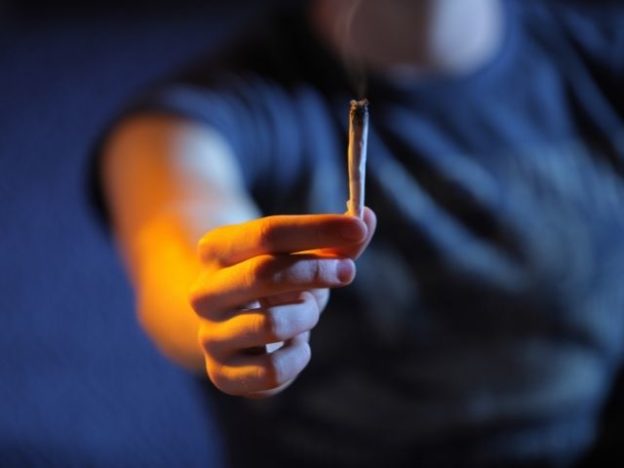Obviously, the landscape of attitudes toward the use of marijuana has changed dramatically in recent years. One of the pieces of conventional wisdom in the drug world was always that marijuana was the most common “gateway” drug. With the widespread acceptance of THC and CBD products for medicinal and recreational use in various portions of the country, this has become a point of contention in recent years.
Those who argue against the so-called “gateway” theory of marijuana point out that there are no documented marijuana-specific properties that “cause” an individual to use other drugs down the road. While this claim is only partially true (we’ll briefly examine the science later in this post), the argument is fundamentally missing the point.
As an aside, in a recent survey of our patient charts, we found that marijuana is the most common “first drug” used by teens with substance use disorders.
To illustrate what we mean:
We surveyed our opiate users about marijuana use
Our (adolescent and young adult specific) substance abuse program did a year-long quick survey of all the opiate and heroin addicts who went through treatment in our facility.
We asked a simple question – did you start with opiates? The answer, a resounding no. Then we asked the obvious follow up question – which drug did you use first? Almost every response was … marijuana.
Surprised? Neither were we.
Rather than getting into the weeds (pun intended) about the clinical properties of marijuana, we prefer a common sense approach to the question. Is it true that marijuana is often the drug that opens the door to further drug use down the road, and if so, why?
A personal anecdote about marijuana
In other portions of this website, we’ve presented some stories about the teenage experience with drug use. I’ll add a portion of my own story:
As a young teenager, I was decidedly anti-drug. My family did a great job of discouraging me from using drugs as well as providing me with suitable alternatives such as hobbies and sports. Not only that, I went through the now defunct D.A.R.E. program as a kid.
I remember the D.A.R.E. officer talking about how people who used marijuana would inevitably experience serious consequences. Despite having some drug-using friends at school, I stayed clean, mostly because I didn’t want to compromise athletics. Then a curious thing happened:
One summer, I smoked weed for the first time. I took a few puffs of a joint at a concert and enjoyed the light, heady feeling I got from it. I didn’t get very high, but the experiment went so well that I decided to do it again – this time I would make sure to get good and high!
A week or two later, I smoked weed from a bong for the first time with some friends and … I had a great time! That’s right – I didn’t commit any crimes, steal from my grandma, join a gang, or try to jump from a high window. That was the day I realized:
Adults are jerks.
They had lied to me.
Drugs were awesome.
My whole attitude toward drug use changed in an instant. I had believed that doing drugs was stupid, but at that point I “realized” that the joke was on me. Within a few weeks, I repeated the experiment with prescription painkillers, cocaine, and over-the-counter cough medications. I began stashing drugs in my room and I quickly fell in love with getting high.
Unsurprisingly, things did get really dark for me. A few years later I was strung out on heroin, homeless, and on the verge of losing ties to my family.
Turns out the joke was on me. I went through the process of getting sober kicking and screaming. But here’s the point:
It all started at that concert, with those first few puffs of marijuana. An “innocent” moment in time where I went from being a capable, athletic, suburban kid to someone open to the idea of doing drugs.
Lowering the barrier to drug use
The 2020 Arizona Youth Survey points out some telling facts about youth substance abuse:
- 41.3% of students surveyed have used marijuana by the time they are in the 12th grade.
- 35.8% of students have used marijuana concentrates by the 12th grade.
- 28.0% have taken marijuana edibles by 12th grade.
The number of 18 year olds who have used marijuana is approaching half.
We also know from this 2014 study that 44.7% of individuals with lifetime cannabis use progressed to other drugs later in life.
Why is this? Is it something “special” about marijuana? Doubtful – we could likely make the same argument about alcohol or vaping. We think it has more to do with perception of risk.
Luckily, the AYS gives us data on this topic as well:
Perception of Risk for Marijuana Use Among Youth
The Arizona Youth Survey goes on to say:
- Only 23.3% of 12th graders perceive trying marijuana once or twice to be a moderate or great risk.
- 87.3% of 12th graders perceive trying illegal drugs other than marijuana to be a moderate or great risk.
There’s two conflicting facts here: while almost all students perceive trying other illegal drugs to be a great risk, almost half of marijuana users go on to use other drugs. That should tell us something – once someone tries their first drug, their perception of the risks of other drug use often gets lowered by default.
Some Common Sense Facts About Marijuana Use
We believe (and see in our drug abuse program every day) that the gateway effect is not referring to a scientific phenomenon – it’s referring to behavioral and social factors that open the door to drug use in general. Consider the following:
- A teenager having fun using one drug is more likely to hear from another teenager that another drug is also fun.
- As noted above, most teens view other illegal drugs as risky at first. Having a good time using one drug makes other, harder drugs seem less scary to try.
- Starting to use drugs plugs teenagers into a social network of drug-using peers, some of whom have access to drugs other than marijuana.
- Taking one drug regularly leads to tolerance. This leads to a natural inclination to try other drugs as time goes on.
An overview of the science on marijuana
Earlier we noted that the claim that marijuana doesn’t directly lead to other drug use is only partially true. Here’s an overview of what the science says:
Marijuana’s association with other drug use
- This 2014 study found that 44.7% of individuals with lifetime cannabis use progressed to other drugs later in life.
- The National Survey on Drug Use and Health found that marijuana users are three times more likely to become addicted to heroin.
- A 2018 study found that cannabis use was associated with non-medical opioid use in adults.
- This 2004 study found that early cannabis use is strongly associated with use, abuse, and dependence on other illicit drugs later in life.
Cross sensitization, or the “priming” effect
Early-use marijuana has been shown to “prime” the brain, setting the person up for substance use disorders later in life. The term cross-sensitization is used to describe the effect of exposure to one drug leading to hypersensitivity to another drug. It has been shown that marijuana use early in life does lead to cross-sensitization for other drugs, which may help explain the high number of users who switch to other drugs later on.
- In their article on cross-sensitization, the Addiction Policy Forum had this to say: “Marijuana is an undeniably powerful drug, like alcohol and tobacco, changing the brain and accelerating drug-reward learning.”
- This study from 2004 found that an enduring change to the dopamine system takes place in those who use cannabis early in life. This adaptation led to a long-lasting cross tolerance for drugs like cocaine, morphine, and amphetamine.
- A more recent study from 2020 performed on rats found that exposure to marijuana during adolescence led to cross-sensitization for cocaine, but adulthood exposure did not. They also reversed the experiment, finding that cocaine use did not lead to cross-sensitization for marijuana.
What about Alcohol and Tobacco?
As compelling as all of this may seem, it turns out that other drugs may have the same effect. For instance, the cross sensitization effect has also been shown in the literature to take place in those who use alcohol or nicotine.
It appears that it may not matter which drug a person does first. As we’ve already stated, it’s likely just the simple fact that someone tries a drug that helps predispose them to other illicit drug use later in life. In their resource on the “gateway effect” of marijuana, the National Institute on Drug Abuse had the following to say:
“An alternative to the gateway-drug hypothesis is that people who are more vulnerable to drug-taking are simply more likely to start with readily available substances such as marijuana, tobacco, or alcohol, and their subsequent social interactions with others who use drugs increases their chances of trying other drugs.”
So … is marijuana a gateway drug?
Hopefully this article has painted a clear enough picture. As stated in the beginning, we’ve hardly ever met a drug abuser who didn’t start with marijuana. We believe practical experience speaks louder than words.
There is massive pressure to be dismissive of some of the common sense wisdom concerning marijuana use. The fact remains that marijuana is almost always the first drug kids try.
Even if it weren’t for the well documented physical health and mental health risks of marijuana, it would still be true that using marijuana early in life sets in motion the social, behavioral, and emotional wheels in motion for other drug use later in life.





